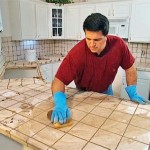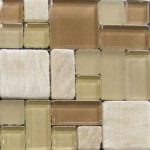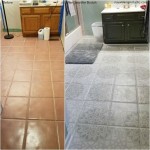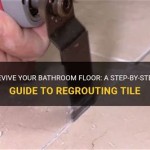What Can I Use To Get Dried Grout Off Tiles and Shower?
Dried grout on tiles and shower surfaces is a common problem following tiling projects or even from regular shower usage. The hardened residue can be unsightly and difficult to remove, requiring specific tools and techniques to avoid damaging the underlying surfaces. This article explores various methods and cleaning agents effective in removing dried grout, while emphasizing the importance of testing solutions in an inconspicuous area first.
Understanding the composition of grout is essential for selecting the appropriate cleaning method. Grout is primarily a mixture of cement, water, and sometimes sand, pigments, and polymers. Its porous nature allows it to absorb water and cleaning solutions, which can affect its structural integrity and appearance. Different types of grout, such as cementitious, epoxy, or urethane grout, require different approaches due to their varying chemical properties and resistance to different cleaning agents.
The primary goal is to soften and dissolve the dried grout without harming the tile, sealant, or surrounding surfaces. This process may involve a combination of chemical solutions, manual scrubbing, and potentially specialized tools. It is crucial to prioritize safety by wearing gloves, eye protection, and ensuring adequate ventilation during the cleaning process.
Vinegar and Water Solution
Vinegar, specifically white vinegar, is a mild acid that can effectively dissolve certain types of grout residue. Its acidic nature breaks down the mineral content of the grout, causing it to loosen and become easier to remove. The effectiveness of vinegar depends on the type of grout and the severity of the residue. For best results, dilute the vinegar with water to prevent potential damage, especially to natural stone tiles or sensitive grout sealants. A common starting ratio is 1:1, vinegar to water, but the concentration can be adjusted based on the level of difficulty.
To apply the vinegar solution, first thoroughly wet the affected area with the mixture. Allow the solution to dwell on the dried grout for at least 15-30 minutes, giving it time to penetrate and soften the residue. For particularly stubborn grout, multiple applications and longer dwell times may be necessary. After the soaking period, scrub the area using a non-abrasive sponge, scrub brush, or grout brush. Avoid using steel wool or harsh abrasive pads, as these can scratch the tile surface.
After scrubbing, rinse the area thoroughly with clean water to remove any remaining vinegar solution and loosened grout. Ensure all traces of vinegar are removed, as its residual acidity can potentially affect the grout's integrity or cause discoloration over time. Wipe the area dry with a clean cloth to prevent water spots and further staining. This method is generally safe for most types of tile and grout, but testing it in an inconspicuous area is still recommended to verify compatibility.
Commercial Grout Cleaners
Numerous commercial grout cleaners are specifically formulated to dissolve dried grout and remove staining. These cleaners often contain stronger chemicals than vinegar and can be more effective on stubborn grout residue. However, it is essential to carefully review the product label and instructions before use, as some cleaners may be too harsh for certain types of tile or grout.
Many commercial grout cleaners are available in spray or liquid form. Apply the cleaner directly to the dried grout, following the manufacturer's instructions for dwell time. Some cleaners require only a few minutes of dwell time, while others may recommend up to an hour for optimal results. Always use gloves and eye protection when handling commercial grout cleaners, as they can be irritating to the skin and eyes.
After the recommended dwell time, scrub the area with a non-abrasive sponge or grout brush. Similar to the vinegar method, avoid using harsh abrasives that could damage the tile surface. Rinse the area thoroughly with clean water to remove all traces of the cleaner and loosened grout. Multiple applications may be necessary for particularly stubborn areas. After rinsing, wipe the area dry with a clean cloth. Consider applying a grout sealant after cleaning to protect the grout from future staining and water damage.
When selecting a commercial grout cleaner, consider the type of tile and grout you are cleaning. Some cleaners are specifically formulated for ceramic or porcelain tile, while others are designed for natural stone. Ensure the cleaner is compatible with the type of grout you have, whether it is cementitious, epoxy, or urethane. Always test the cleaner in an inconspicuous area first to ensure it does not cause discoloration, etching, or other damage.
Steam Cleaning
Steam cleaning is a chemical-free method for removing dried grout that uses high-temperature steam to loosen and dissolve the residue. The steam penetrates the pores of the grout, breaking down the bond between the grout and the tile surface. Steam cleaning is particularly effective at removing dirt, grime, and mold from grout, in addition to dried grout residue.
To use a steam cleaner, fill the appliance with water according to the manufacturer's instructions. Allow the steam cleaner to heat up and generate a steady stream of steam. Attach the appropriate nozzle or brush attachment for grout cleaning. Direct the steam nozzle at the dried grout, moving slowly and steadily along the grout lines. The steam will loosen the grout, allowing it to be wiped away with a clean cloth.
For particularly stubborn grout, hold the steam nozzle in place for a longer period to allow the steam to penetrate and dissolve the residue. Scrub the area with a grout brush while steaming to agitate the grout and further loosen it. The combination of steam and scrubbing action can effectively remove even hardened grout residue. Wipe away the loosened grout with a clean cloth as you go.
Steam cleaning is generally safe for most types of tile and grout. However, it is important to avoid prolonged exposure of steam to sensitive surfaces, such as painted walls or wood trim. Always test the steam cleaner in an inconspicuous area first to ensure it does not cause any damage. Steam cleaning can also be used to sanitize the grout and kill mold or mildew, making it a versatile cleaning method for bathrooms and kitchens.
Grout Removal Tools
For extremely stubborn dried grout, manual grout removal tools may be necessary. These tools are designed to mechanically remove the grout without damaging the surrounding tile. There are several types of grout removal tools available, including grout saws, grout scrapers, and oscillating tools with grout removal attachments.
Grout saws are hand-held tools with a toothed blade that is used to cut through the grout. They are effective at removing large pieces of dried grout, but require careful handling to avoid scratching the tile. Grout scrapers are similar to putty knives, but with a narrower blade designed to fit within the grout lines. They are used to scrape away the surface of the grout.
Oscillating tools with grout removal attachments are power tools that vibrate at high speeds, allowing for precise grout removal. These tools are more efficient than manual grout saws and scrapers, but also require careful handling to prevent damage to the tile. Before using any grout removal tool, carefully review the manufacturer's instructions and practice on a small, inconspicuous area to become familiar with the tool's operation.
When using a grout removal tool, apply gentle pressure and work slowly to avoid chipping or cracking the tile. Use the tool to carefully remove the dried grout, following the grout lines. Avoid pressing too hard or forcing the tool, as this can damage the tile. After removing the grout, clean the area thoroughly to remove any debris. Consider applying a grout sealant to protect the new grout from future staining and water damage.
Baking Soda Paste
Baking soda offers a mildly abrasive and alkaline cleaning solution. Its gentle abrasive properties help to physically scrub away the dried grout, while its alkalinity can help to dissolve some types of stains and residues. Baking soda is generally safe for most types of tile and grout, but it is still recommended to test it in an inconspicuous area first.
To create a baking soda paste, mix baking soda with water until you achieve a thick, spreadable consistency. Apply the paste directly to the dried grout and allow it to sit for 5-10 minutes. The dwell time allows the baking soda to soften the grout and penetrate any stains or residues. After the dwell time, scrub the area with a non-abrasive sponge, scrub brush, or grout brush.
The slightly abrasive nature of baking soda will help to loosen and remove the dried grout. Rinse the area thoroughly with clean water to remove all traces of baking soda paste and loosened grout. Wipe the area dry with a clean cloth. For particularly stubborn grout, you can try mixing baking soda with vinegar to create a more potent cleaning solution. However, be aware that this combination will produce a fizzing reaction, so use it cautiously and avoid using it on natural stone tiles.
Baking soda paste is a versatile and environmentally friendly cleaning solution that can be used on a variety of surfaces. It is a good option for removing mild to moderate dried grout residue and can be used as a regular maintenance cleaner to keep grout looking clean and bright.
Preventive Measures
Preventing grout from drying on tiles in the first place is the most effective way to avoid the need for aggressive cleaning methods. During tiling projects, wipe away excess grout as soon as possible using a damp sponge. Regularly rinsing the sponge in clean water will prevent the grout from drying and hardening on the tile surface.
After the grout has cured, apply a grout sealant to protect it from staining and water damage. Grout sealants create a barrier that prevents liquids from penetrating the grout, making it easier to clean and maintain. Reapply grout sealant periodically, according to the manufacturer's instructions, to maintain its protective properties.
Regular cleaning of tiled surfaces will also help to prevent grout from drying and hardening. Use a mild detergent and water to clean the tiles and grout on a regular basis. Avoid using harsh abrasive cleaners, as these can damage the grout and tile surface. Promptly address any spills or stains to prevent them from setting into the grout. By taking preventive measures, you can keep your tiled surfaces looking clean and new for years to come.

How To Get Rid Of Leftover Grout Haze Quickly And Easily The Creek Line House

How To Clean Dried Grout North Country Nest

4 Ways To Clean Grout Off Tile Wikihow

How To Clean Bathroom Tile And Grout Reviews By Wirecutter

How To Clean Grout Two Ingredient Diy Cleaner Lemons Lavender Laundry

Here S How Remove Mildew From Bathroom Tile Grout

How To Clean Grout Tips For Natural Stone Flooring Granite Gold

How To Clean Mold In Shower Grout Tips And Tricks Certified Care

How To Remove Hard Grout From Tiles Diy Doctor

How To Clean Black Moldy Shower Or Kitchen Tile And Silicone Caulking Two Methods No Scrubbing
Related Posts








